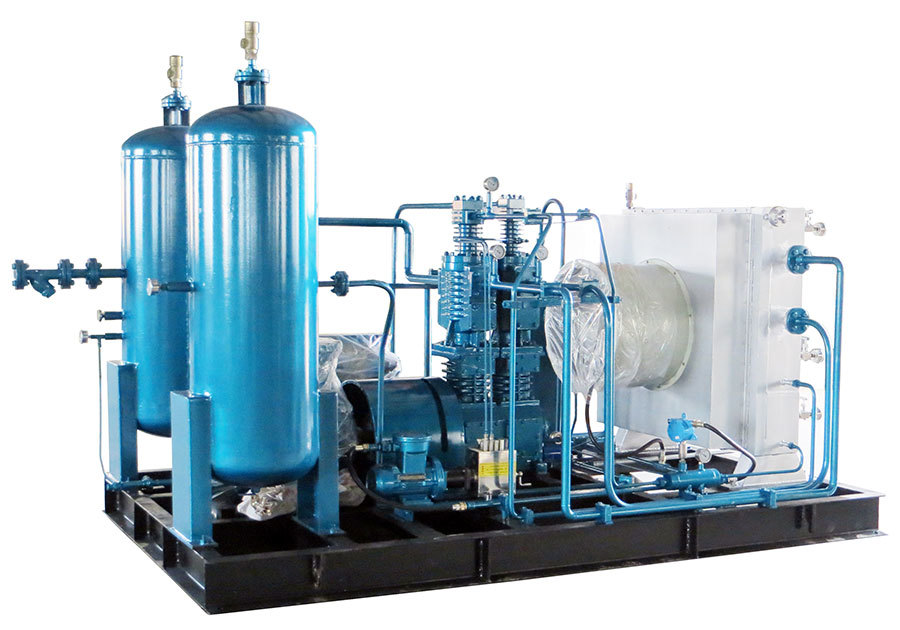newest BOG compressor
Release time:
Jun 16,2025
Source:
The BOG compressor is specially engineered to handle boil-off gases in cryogenic applications, playing a vital role in LNG logistics and vapor management. It compresses evaporated LNG vapors, commonly known as boil-off gas, to reinject them into the system or direct them for energy recovery, ensuring pressure balance and fuel conservation.
Product Introduction
In recent two years, all cities in China are building LNG stations, LNG storage equipment volatile flash vapor, that is, BOG gas, in order to make full use of this part of the gas, through the compressor will be BOG gas pressurization to a certain pressure and then directly supplied to the city pipeline network, but also can be pressurized to 250 kg to be transported to the CNG station to use.
Main Specifications
| Structural type | Vertical (Z) |
| Suction pressure | 0.05~0.6MPa |
| Discharge pressure | 0.4~25MPa |
| Flow range | 50~2900NM3/h |
| Motor power | 160~315kw |
| Cooling Method | Air or Water Cooling |
| Application | LNG storage equipment volatilized flash vapor, namely BOG gas, in order to make full use of this part of gas, BOG gas can be pressurized to a certain pressure through the compressor and directly supplied to the city pipe network for use, or can be pressurized to 250bar and transported to CNG station for use. |
Technical parameters and specifications
| Serial No. | Model Number | Medium | Flow (Nm3/h) | Inlet pressure (MPaG) | Exhaust Pressure |
| (MPaG) | |||||
| 1S | ZW-4/0.5-5 | BOG | 300 | 0.05 | 0.5 |
| 2 | ZW-4.0/(1-5)-6 | BOG | 400~1200 | 0.1~0.5 | 0.6 |
| 3 | ZW-0.32/(2-6)-10 | BOG | 50~110 | 0.2~0.6 | 1 |
| 4 | ZW-0.32/(3-5)-40 | BOG | 60~100 | 0.3~0.5 | 4 |
| 5 | ZW-0.55/6-250 | BOG | 200 | 0.6 | 25 |
| 6 | DW-12/2 | BOG | 600 | atm | 0.2 |
| 7 | ZW-6/(2-6) -7 | BOG | 900~2000 | 0.2~0.6 | 0.7 |
| 8 | VW-14/(1-3)-4 | BOG | 1400~2900 | 0.1~0.3 | 0.4 |
| 9 | ZW-4/(1-6)-7 | BOG | 400~1400 | 0.1~0.6 | 0.7 |
| 10 | ZW-4/(1.5-6)-8 | BOG | 500~1400 | 0.15~0.6 | 0.8 |
| 11 | ZW-2.5/(0.5-4)-(3.5-7) | BOG | 190~640 | 0.05~0.4 | 0.35~0.7 |
| 12 | ZW-0.45/(10-40)-40 | BOG | 250~950 | 1.0~4.0 | 4 |
| 13 | ZW-0.4/6-10 | BOG | 140 | 0.6 | 1 |

The BOG compressor is specially engineered to handle boil-off gases in cryogenic applications, playing a vital role in LNG logistics and vapor management. It compresses evaporated LNG vapors, commonly known as boil-off gas, to reinject them into the system or direct them for energy recovery, ensuring pressure balance and fuel conservation.
This BOG compressor features a corrosion-resistant build and cryogenic-grade components, enabling it to function effectively under extreme cold temperatures. Its robust design ensures uninterrupted performance, even under variable load conditions. The compressor supports both continuous and intermittent operations, making it versatile for a range of industrial uses.
With automated controls and real-time monitoring, the BOG compressor provides operators with accurate feedback on pressure, flow, and temperature, allowing for optimized gas management. Its high-efficiency drive system reduces energy consumption, while its modular design simplifies maintenance and system upgrades.
Used extensively in LNG terminals, marine LNG carriers, and gas processing plants, the BOG compressor enhances safety, improves fuel efficiency, and ensures regulatory compliance by capturing and compressing excess vaporized gas before it escapes into the atmosphere.
Related news
Circulating Gas Compressors: Transforming the Manufacturing Landscape
Circulating Gas Compressors: Transforming the Manufacturing Landscape Table of Contents 1. Introduction to Circulating Gas Compressors 2. What Are Circulating Gas Compressors? 3. How Do Circulating Gas Compressors Work? 4. Key Applications of Circulating Gas Compressors in Manufacturing 5. Benefits of Using Circulating Gas Compressors 6. Challenges and Considerations in Im
Understanding Hydraulic Piston Compressors: Key Insights for Professionals
Hydraulic piston compressors are vital components in various manufacturing processes, serving as the backbone for converting mechanical energy into compressed air or gas. These machines utilize hydraulic force to drive the pistons, enabling them to compress gases efficiently. Understanding the operational principles and applications of hydraulic piston compressors can significantly enhance product
Unlocking Efficiency: The Role of Hydraulic Piston Compressors in Manufacturing
Unlocking Efficiency: The Role of Hydraulic Piston Compressors in Manufacturing Table of Contents 1. Introduction to Hydraulic Piston Compressors 2. Understanding Hydraulic Piston Compressors 3. Mechanical Design and Operation of Hydraulic Piston Compressors 4. Applications of Hydraulic Piston Compressors in Manufacturing 5. Benefits of Hydraulic Piston Compressors in Manufact
The natural gas compressor features a multi-stage compression system that maximizes efficiency while minimizing energy consumption. With precision-engineered components and superior heat management, it maintains consistent performance throughout extended operational periods.
The CNG compressor boasts a multi-stage compression system that maximizes efficiency while minimizing energy waste. With superior heat dissipation and vibration control, it delivers smooth and quiet operation. The compressor’s modular design allows for easy maintenance and quick part replacement,
The Essential Guide to Hydraulic Piston Compressors in Manufacturing
Hydraulic piston compressors are a vital component in various manufacturing and processing industries, playing a crucial role in converting hydraulic energy into mechanical energy. These compressors are designed to compress gases for various applications, making them indispensable in situations where high pressure and efficiency are required. At the core of hydraulic piston compressors is the pist

